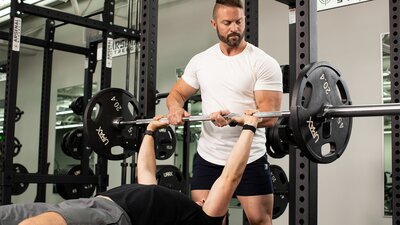
Spotting 101: How to Spot the Bench, Squat, and Dumbbell Press
Spotting isn't just a question of etiquette; it's how you can help a friend hit a PR and not get injured in the process. Learn the fundamentals and spread the word!
It's easy to believe that spotting is just a question of gym etiquette, like wiping down machinery or putting away weights. It's something you know you should do, but never really give much thought.
Lifters who push themselves in the gym know better. To them, knowing when to ask for a spot—and knowing how to spot someone when they ask—is like wearing a seat belt. It doesn't seem like that big of a deal until you really need it. And if you keep training long enough, you'll have a few stories about someone who needed it.
Here's what you need to know about spotting, and how to do it correctly, for the lifts that require it most often.
The Essentials of Spotting
Spotting is when one person steps in to actively monitor and (if necessary) help someone while they're lifting fairly close to the limits of their ability. It's something you'll see a good personal trainer doing for their client, but it's also common for training partners. But it's also something that strangers ask one another to do in a commercial weight room.
Simply put, your job as a spotter is to make the lift safe. This might mean simply being present so the lifter feels comfortable lifting, or it might mean something more hands-on, like helping rack and unrack the weight. On occasion, you may be called to help in max-effort reps or during overload work like dropsets or forced reps, like hypertrophy coach Paul Carter outlines in his article, "4 New Ways to Get the Most Out of Your Spotter."
The most common exercises that require a spotter are bench press, back squat, and dumbbell press—both chest and shoulder presses. Each one has some unique needs and challenges, but they all have these elements in common when it comes to being a good spotter:
- Ask how many reps they're planning to perform.
- Ask if they want help unracking or getting the weights into position.
- Pay attention throughout the set.
- Don't help or touch the weights unless it's necessary.
- Seriously: Pay attention!
That's your universal spotting checklist. Now here's what you need to know about each lift.
Spotting the Bench Press
- Help "lift off" the bar if needed with your hands inside the lifter's hands.
- Do not touch the bar unless necessary.
- Be prepared to grab the full weight quickly.
- Use a mixed grip, particularly on heavy bars.
- Help re-rack the bar.
Why Spotting is Necessary:
The bench press is the lift where the most people want to "max out" by lifting to the point of muscle failure, but it is also one that involves heavy weight hovering over the torso of the lifter. That's a spicy combo! Sure enough, most of us learn about spotting for the first time when we see someone sprint over to help lift a bar that is crushing someone's vital organs.
How and When to Help: Almost every lifter will ask you to assist with unracking the bar, a move known as a "lift off." To do this, grip the bar with both of your hands close together inside of the lifter's grip. Wait for their cue, then help bring the bar over their chest to the proper starting position. Once the bar is in position, verbally confirm that they are ready for you to let go.
During the set, you may need to keep your hands near the bar, but it is important that you do not touch it—this is not a team lift! A good strategy is to hold your hands in a so-called "mixed grip," with one hand over the bar and one hand under. This grip will be quite strong in the event you need to quickly grab the weight.
Don't let small joints hold you back on big lifts. Supporting your wrists with wraps can mean a stronger, safer bench on chest day. - View All
If the lifter gets stuck and asks for help, or if the bar starts moving down, assist with full force. It can be hard to tell the difference between normal struggle and true muscle failure, which is why it's crucial to communicate with your lifter. When in doubt, it's better to help—even if you risk making your lifter angry.
Forced Reps: During the set, the lifter might ask you to help with a rep after they reach failure, or what are known as "forced reps." It sounds risky, but it's a time-honored way to boost your bench. In this situation, you only need to give the amount of help needed to complete the lift. There is no need to fully take on all the weight unless it's clearly failing. It's their workout, so allow them to work on each rep as much as they can.
Spotting the Squat
- Be in the spotting position for racking and unracking.
- Support the lifter, not the bar.
- Stay close without interfering.
- If the lifter starts moving down, assist immediately.
Why Spotting is Necessary:
The barbell back squat is one of the heaviest lifts, and one of the most technical, both to perform and to spot. For these reasons, you should always squat in a rack that has pins or "safeties," ensuring they are at the correct height before beginning.
Further complicating matters is that so many different bad things can happen during a heavy squat: a squatter could buckle forward, bust a knee, break an ankle, pass out, or mishandle either unracking or re-racking the weight. As strength coach Charles Staley explains in the article, "7 Ways You're a Serious Workout Injury Waiting to Happen," these incidents can happen with no warning, to experienced lifters as well as newbies.
How and When to Help: If the lifter's reps slow down or start looking shaky, tighten up and be ready. If they start moving back down at all after attempting to come up, get in there!
If they're not lifting super-heavy, spotting them by placing your hands on their obliques can be good enough. This can also avoid some potentially awkward situations between male trainers and female clients or vice versa.
However, when serious heavy weights are on the bar, the rules change: Wrap your arms under theirs and across the chest or shoulders, and help them up as much as needed.
Heavy squats play by their own rules. A supportive leather or nylon lifting belt can help you truly challenge your legs, without making your back cry uncle. - View All
Spotting the Dumbbell Press
- If asked, help get the dumbbells into position.
- Stand behind the lifter.
- Spot at the wrists, not the elbows!
- Help lower to avoid dropping.
- Take direction from the lifter.
Why Spotting is Necessary:
Dumbbells offer benefits that barbells don't, like extra range of motion and muscle activation. But they also double the threat posed by barbells, since they raise the possibility of two separate weights falling instead of just one. They're also more complicated to get into place, and there's no rack to leave them on at the end of the set. For that reason, it's no wonder that hardcore bodybuilders like Kris Gethin prefer to toss them on the floor at the end of the set while annihilating shoulders or chest.
How and When to Help: For both shoulder and chest presses, the dumbbells start on the knees and the lifter rocks them up into position. As a spotter, you must already be in position behind the lifter to help move and steady the dumbbells into position for the first rep. Once in position, let go and keep your hands off unless help is needed.
If help is needed, position your hands at the wrists to spot the dumbbell press, not the elbows. Why? Because the lifter's elbows could buckle inward and the spotter would have no way to stop the weight from falling, potentially on the lifter's head or face. Not good!
Like everything in the weight room, spotting gets better with practice. So don't just read this guide! Commit it to heart, then put it into action. Offer to spot someone and also ask someone to spot you. And if you want to get really serious, start lifting with a training partner—it can even be your romantic partner—and try a full-on partner-based lifting program like "Duel: Marc Megna's 6-Week Partner-Based Fitness Plan."
